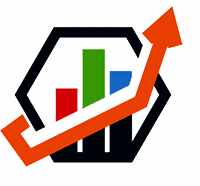What Is Financial Analytics Software?
Businesses can use financial analytics software to make data-driven decisions and obtain insightful information about their financial operations. To give a thorough picture of the business's financial performance, this software integrates financial data from multiple sources, including accounting software, budgeting tools, and market data.
Fundamentally, financial analytics software is made to examine financial data and display it in an understandable and visual manner using dashboards, graphs, and charts. In order to make well-informed decisions and plan for the future, organizations can utilize this to swiftly spot trends, patterns, and anomalies in their financial data.
For companies that must quickly and accurately interpret vast amounts of financial data, this kind of software is essential. It offers comprehensive analysis of numerous financial issues, including cash flow, budgeting, forecasting, and risk management, in addition to assisting in the tracking of important financial metrics like sales, expenses, and profits.
Real-time data analysis, dashboard customization, predictive analytics, and teamwork are a few of the main characteristics of financial analytics software. In addition to gaining a comprehensive understanding of their financial performance, these features enable organizations to work together with stakeholders and team members to improve decision-making.
Financial analytics software is used in typical accounting and financial tasks, but it can also be used in other fields including operations, marketing, and sales. It can assist in finding ways to cut costs, refining pricing plans, and raising overall profitability.
It is crucial to assess your unique business requirements and select a solution that provides the appropriate feature set and functionality when thinking about investing in financial analytics software. Businesses may make educated decisions, expedite their financial procedures, and eventually spur growth and success with the help of the correct financial analytics software.
What Are The Recent Trends In Financial Analytics Software?
Current Trends in Financial Analytics Software: Businesses of all sizes have been using financial analytics software more and more in recent years. The way businesses handle financial management has been completely transformed by this cutting-edge technology, which offers insightful analysis and data-driven decision-making. The market for financial analytics software has grown significantly along with the desire for more intelligent and efficient financial tools, with a number of trends emerging to address changing corporate needs.
1. Integration With Artificial Intelligence (AI): Businesses are revolutionized by the incorporation of AI and machine learning technologies into financial analytics software. These sophisticated technologies allow businesses to make data-driven decisions instantly by swiftly analyzing big financial data sets, finding trends, and forecasting outcomes. Financial analytics software can identify possible risks and opportunities, produce more accurate projections, and expedite financial procedures by utilizing AI capabilities.
2. Cloud-Based Solutions: Cloud-based financial analytics software is becoming more and more popular as remote work becomes more common and there is a demand for more flexible and adaptable solutions. These systems have a number of benefits, including as cost effectiveness, ease of maintenance, and quick access to real-time data. Additionally, cloud-based solutions offer smooth interaction with other company systems, which facilitates departmental sharing of financial data.
3. Put An Emphasis On Predictive Analytics: This expanding field of financial analytics software enables companies to foresee future developments and take preventive measures. Businesses can use predictive analytics to foresee shifts in the market, spot possible hazards, and implement remedial measures to boost output. Businesses can gain a competitive advantage by using this expertise to remain ahead of the constantly shifting market conditions.
4. Data Visualization: Data visualization is more important than ever due to the growing volume and complexity of financial data. These days, a lot of financial analytics software programs come with sophisticated data visualization features to aid users in rapidly interpreting large, complicated data sets. Businesses may more easily monitor financial performance and pinpoint important insights with the help of these tools, which offer visual representations of financial data in the form of charts, graphs, and dashboards.
5. Greater Attention To Cybersecurity: As financial analytics software usage grows, so does the demand for strong security measures. Improved cybersecurity features like data encryption, multi-factor authentication, and user access limits are recent trends in financial analytics software. These features give companies peace of mind and shield private financial information from online attacks.
Benefits Of Using Financial Analytics Software
For companies of all sizes, financial analytics software is an effective tool that offers insightful information and data-driven financial strategy decision-making. It provides a number of advantages that make it a vital tool for businesses trying to maximize their profits.
1. Precise and Instantaneous Data Evaluation: The capacity of financial analytics software to gather, evaluate, and display precise and up-to-date data is among its most important benefits. Using this data, one may monitor financial performance, spot trends and patterns, and make well-informed decisions based on current knowledge.
2. Better Budgeting And Financial Planning: Businesses can develop comprehensive financial plans and budgets with financial analytics software by using both historical and current data. This reduces financial risks and maximizes possible opportunities by enabling more precise forecasting and planning.
3. Finding Opportunities To Reduce Costs: Businesses can examine their financial data in-depth to find areas for cost savings by utilizing financial analytics software. In order to improve the bottom line, this may entail examining spending, spotting areas of excessive spending, and figuring out how to cut costs.
4. Risk Mitigation: Complex financial data may be analyzed by financial analytics software, which can also spot possible dangers before they become serious problems. By taking a proactive stance, companies can reduce risks and avoid possible financial losses by acting quickly.
5. Financial Reporting: Simplified For larger businesses with complicated financial data, creating financial reports may be a difficult and time-consuming operation. Businesses can save time and cut down on errors by automating the reporting process with financial analytics software.
6. Improved Ability To Make Decisions: Software for financial analytics gives companies useful information and insights that can guide strategic choices. Businesses can improve their financial results by adopting a data-driven approach, which enables them to make more intelligent and efficient decisions.
7. System Integration: Numerous financial analytics software programs interface with accounting and ERP software, among other company systems. This saves time and lowers the possibility of human error by enabling a smooth data flow and doing away with the necessity for manual data entry.
Important Factors To Consider While Purchasing Financial Analytics Software?
In order to choose the best choice for their particular requirements, buyers of financial analytics software should take into account a few important factors. These elements include the pricing, simplicity of use, compatibility, and features of the software. Features: The software's features should be the first and most crucial consideration. Strong tools for data analysis, forecasting, and reporting should be included in financial analytics software.
1. Compatibility: Compatibility with current systems is another important consideration. Workflows should be streamlined by the software's ability to interact with databases and other pertinent technologies. Because larger firms may have numerous systems in place, compatibility is especially crucial. The software's compatibility with the existing infrastructure must be guaranteed.
2. Ease Of Use: All user levels should be able to easily explore and utilize financial analytics software. Along with extensive training and customer support options, it should feature an easy-to-use interface. Buyers should also take into account the resources needed for software implementation and maintenance, as well as the learning curve.
3. Cost: Another important consideration is the software's price. The entire cost of ownership, including maintenance, support, and licensing fees, should be taken into account by buyers in addition to the purchase price. Finding the greatest deal for the company requires comparing the costs of several solutions. Data Security: Purchasing financial analytics software should take data security into account as it is a major concern for financial firms. Strong security features should be included in the software to safeguard private financial information. This covers access control, encryption, and user authentication.
4. Vendor Reputation: Lastly, purchasers ought to investigate the vendor's standing in the marketplace. They ought to examine case studies, client testimonials, and the business's financial standing. Assessing the vendor's customer service quality and if they provide software upgrades and continuing support is also crucial.
What Are The Key Features To Look For In Financial Analytics Software?
Software for financial analytics is an effective tool that helps companies understand their financial data and make wise decisions. It can be difficult for consumers to choose the software that best suits their individual requirements when there are so many solutions available.
The following are the main characteristics to search for in financial analytics software to assist you in making an informed choice:
1. Data Visualization: The capacity to display data in a variety of formats, including charts, graphs, and dashboards, is a crucial feature to search for in financial analytics software. This facilitates the understanding and interpretation of information by enabling users to quickly spot trends and patterns in huge datasets.
2. Customizable Dashboards: Select a program that has dashboards that may be altered to meet your unique company requirements. In addition to offering a customized and individualized user experience, this will enable you to measure and monitor the key performance indicators (KPIs) that are pertinent to your company.
3. Predictive Analytics And Forecasting: The top financial analytics software should be able to evaluate past data and produce precise projections and predictions for upcoming patterns. Businesses need this functionality in order to make data-driven, strategic decisions.
4. Thorough Reporting: Seek out software with the ability to provide thorough reporting. This will make it possible for you to produce reports that are adaptable for various stakeholders, guaranteeing that everyone has access to the most current and precise financial information.
5. Integration With Current Systems: Your data sources and current systems should be easily integrated with your financial analytics software. This will guarantee that all of your financial information is readily available and able to be examined in a single location.
6. Data Security: Businesses place a high premium on data security, particularly when it comes to financial data. Verify that the software you select has strong security features in place to safeguard your private data.
7. User-Friendly Interface: To guarantee simple software uptake and use, a user-friendly interface is crucial. Choose software that is straightforward to use, especially for non-technical individuals, with an intuitive interface.
8. Scalability: Your financial data will expand together with your business. Selecting software that is scalable and able to manage a rise in data volume without sacrificing performance is crucial.
9. Mobile Compatibility: Selecting financial analytics software that works with mobile devices is essential given the growth of remote work and data access while on the go. This will enable you to view and examine your financial information at any time and from any location.
10. Customer Support: Finally, but just as importantly, pick a software company that provides prompt, dependable customer service. This will minimize any interruption to your company's activities by guaranteeing that any technical problems or inquiries are handled quickly and effectively.
Why Do Businesses Need Financial Analytics Software?
Businesses require financial analytics software because it enables them to make informed and strategic decisions based on reliable, real-time financial data. Given the ever-changing market trends and competitive landscape, a thorough grasp of a company's financial health is critical for development and sustainability. Financial analytics software allows firms to conduct in-depth analyses of their financial data, identifying patterns, trends, and potential dangers.
One of the primary reasons why firms use financial analytics software is to track their key performance indicators (KPI). These metrics offer a comprehensive assessment of a company's financial performance, including sales, expenses, cash flow, and profitability. Tracking KPIs allows firms to immediately discover areas for development and make data-driven decisions that promote growth and profitability.
In addition, financial analytics software assists organizations with planning and forecasting. Using past data and complex algorithms, the software can anticipate future revenues, expenses, and cash flow with high accuracy. This allows firms to plan for different scenarios and make strategic decisions that drive growth while mitigating risks.
Financial analytics software is also useful for risk identification and management. By evaluating data from several sources, the software can detect anomalies or potential fraud, assisting firms in identifying potential dangers before they become serious difficulties. This enables firms to take proactive steps to reduce risks and ensure financial stability.
Furthermore, financial analytics software includes comprehensive reporting features, allowing organizations to generate customized and detailed reports on their financial performance. These reports can be shared with stakeholders, investors, and regulators, increasing transparency and confidence. To summarize, financial analytics software is a critical tool for organizations seeking to remain competitive and grow in today's dynamic market.
It gives accurate and real-time insights into a company's financial health, aids in planning and forecasting, identifies and manages risks, and provides extensive reporting capabilities. By investing in financial analytics software, firms can improve their decision-making processes, generate growth, and achieve financial success.
How Much Time Is Required To Implement Financial Analytics Software?
The time required to develop financial analytics software varies according to a number of criteria. These criteria include the software's complexity, the size and scope of your firm, and the extent of customisation required to meet your specific business requirements. Implementing financial analytics software often takes between a few weeks and a few months.
This timeline comprises the initial setup, data migration, testing, and training phases. Smaller firms with lesser demands can complete the implementation process more quickly. Larger firms, with more complicated data and business processes, may require a longer implementation period.
To ensure that the implementation runs smoothly and efficiently, all important stakeholders must be involved in the planning and decision-making processes. This includes your IT department, the finance team, and any other departments that will be using the software. Working with these stakeholders can assist identify potential bottlenecks and guarantee successful implementation.
Furthermore, the financial analytics software must have a thorough awareness of your company's goals and specific needs. This will allow the implementation team to personalize the program to your organization's specific requirements, saving the time and effort necessary for modification and training.
What Is The Level Of Customization Available In Financial Analytics Software?
Financial analytics software provides a variety of tools and capabilities to assist firms evaluate and manage their financial data. The level of customisation available with different software options is a crucial factor that distinguishes them. Customization refers to the software's capacity to be adjusted to a particular user's demands and requirements. The level of customisation offered by financial analytics software varies based on the software and provider.
However, most software options provide some level of flexibility to accommodate the different demands of enterprises. At its most basic, financial analytics software enables users to personalize their dashboards and reports by selecting which data and indicators to display. This enables customers to focus on the most essential information for their organization and quickly track key performance indicators.
In addition to modifying dashboards and reports, some software allows for more advanced customization, such as the creation of custom formulas and metrics. This is especially valuable for organizations that utilize unique financial computations or metrics based on their industry or company model. Another level of customization in financial analytics software is the ability to design unique workflows and processes.
This enables firms to modify the software to their own business processes and automate jobs, thereby saving time and improving efficiency. Some software alternatives additionally enable for integration with other business systems and data sources, providing even more customisation and a comprehensive view of a company's data. When determining the extent of customisation in financial analytics software, it is critical to evaluate your company's individual objectives and goals.
While some organizations require more personalization, others may find that a less customized alternative satisfies their needs enough. To summarize, financial analytics software provides varying levels of customisation based on the software and provider.
Businesses can customize the software to meet their specific needs and expectations, including custom dashboards and reports, computations, and workflows. Consider your company's demands and goals when comparing the level of customisation in various software alternatives to find the greatest fit for your corporation.
Which Industries Can Benefit The Most From Financial Analytics Software?
Financial analytics software is a strong tool that can aid a variety of businesses, regardless of size or type of firm. This software is intended to analyze vast amounts of financial data and deliver significant insights that can help firms make sound decisions. Whether you run a small business or a major corporation, financial analytics software can be a great addition to your company.
we'll look at which sectors stand to benefit the most from financial analytics software and how it may improve their operations.
1. Banking And Financial Services Industry: Financial analytics software has mostly benefited the banking and financial services sector. This software enables banks and financial organizations to track and analyze financial transactions, manage investments, and identify potential dangers. It also allows them to make data-driven decisions, prevent fraud, and meet regulatory obligations.
2. Retail Industry: Financial analytics software has the potential to transform the retail industry. This program enables businesses to evaluate sales data, maintain inventory levels, and find patterns in consumer behavior. This information can help merchants enhance their pricing strategy and increase overall profitability.
3. Insurance Industry: Financial analytics software can also aid the insurance industry. This software can assist insurance businesses evaluate consumer data, detect potential hazards, and automate the underwriting process. It can also aid in claims administration and fraud identification, resulting in increased operational efficiency and risk reduction.
4. Healthcare Industry: The healthcare industry relies heavily on data management, which financial analytics software may help with. It can assist hospitals and healthcare providers in tracking and analyzing patient data, managing revenue sources, and improving financial outcomes. This program can also help you uncover cost-saving opportunities and improve patient care.
5. Manufacturing Industry: Financial analytics software can also be useful in the manufacturing industry. It can assist manufacturers in analyzing production costs, managing inventory, and optimizing supply chain operations. It can also help in forecasting demand and identifying cost-cutting options, resulting in increased profitability.
6. Professional Service Industry: Financial analytics software can also help professional services organizations like consulting and accounting. It can assist them in tracking billable hours, managing expenses, and analyzing financial data from different clients. This software can also provide real-time insights, allowing professional services firms to make better decisions and improve their productivity.
7. Governmental Organizations: Financial analytics software can also help government institutions like tax agencies and regulatory bodies. It can assist them in analyzing tax data, tracking expenses, and detecting potentially fraudulent activity. It can also help with budgeting and forecasting, allowing governments to make data-driven decisions.
Conclusion
To summarize, selecting the correct financial analytics software is an important decision for any firm. By knowing your individual requirements and taking into account the major criteria highlighted in this buyer's guide, you can make an informed decision that will benefit your business in the long run. Prioritizing features such as data integration, automation, visualization, and advanced analytics capabilities is critical for ensuring that the software fits your needs and facilitates financial analysis.
Furthermore, assessing the pricing, support and training choices, security measures, and software scalability are critical to ensuring a smooth and effective installation. Don't forget to extensively investigate the software provider's reputation, client feedback, and market performance. This can provide insight regarding the software's dependability, usability, and customer support.
By adhering to these recommendations and utilizing the various resources available, you can confidently select the best financial analytics software that corresponds with your business goals and enables you to make data-driven decisions for long-term success.

















